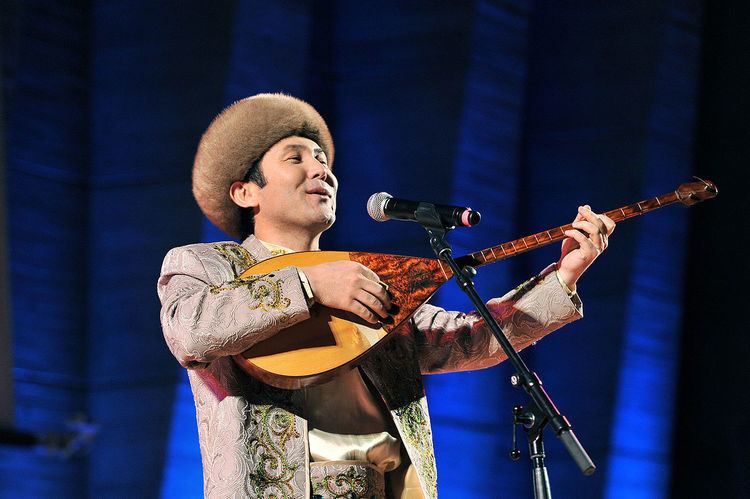 | ||
Classification Plucked string instrument | ||
The dombra (Kazakh: домбыра dombıra; Uzbek: dambura; Bashkir and Tatar: dumbıra, tumpıra, tumra; Turkish: dombıra) is a long-necked Turkic lute and a musical string instrument.
Contents
The instrument shares some of its characteristics with the komuz and dutar.
Varieties
The instrument differs slightly in different regions. The Kazakh dombra has frets and is played by strumming with the hand or plucking each string individually, with an occasional tap on the main surface of the instrument. While the strings are traditionally made of sinew, modern dombras are usually produced using nylon strings. One of the greatest dombra players was the Kazakh folk musician and composer Kurmangazy, who had a great influence on the development of Kazakh musical culture, including music for the dombra; his musical composition "Adai" is popular in Kazakhstan and abroad.
In 2012 the elektrodomra was created.
The Turkestani and Badakhshani damburas are fretless with a body and neck carved from a single block of wood, usually mulberry or apricot. The dambura is played with much banging and scratching on the instrument to help give a percussive sound. The two strings are made of nylon (in modern times) or gut. They cross a short bridge to a pin at the other end of the body. There is a tiny sound hole in the back of the instrument, while the top is thick wood. It is not finished with any varnish, filing/sanding of any kind, and as with all other Turkic instruments there is some decoration.
The Dumbyra is the equivalent instrument of the Volga Tatars and Bashkirs. A performer strikes all the strings at the same time. The upper string performs the bourdon tone and the lower string performs the melody. A dumbura is used as a solo as well as an ensemble instrument.
Dombra, ensemble and epic
The Kazakh poet Abay Qunanbayuli is often shown holding a dombra at rest and many hold it in high regard as a symbol of nationalism among the post-Soviet nations of the Commonwealth of Independent States. The dombra is played by Erzhan Alimbetov in the Ulytau band.
From the 12th to the 18th century, the dumbura was used by Bashkir sasans to accompany their poetic legends and kubairs. It is mentioned in the epic poem "Zayatulyak and Hiuhiliu". However, by the beginning of the 20th century, the dumbura was forgotten. The sasans were often the main ideologists of ethnic insurrections. So when the Russian administration put down an uprising, they punished the sasans and destroyed their dumburas. In the second half of the 20th century, several reconstructions were carried out. At present, the revivalist work continues. Among others, performer V. Shugayupov works on the revival of the dumbura. The modern wooden dumbura has a pear-shaped or an oval form.
Range and tablature
Many folk and regional tunings have been existing though below there is the most accepted academic DG tuning for standard concert dombra prima of Kazakhstan.
